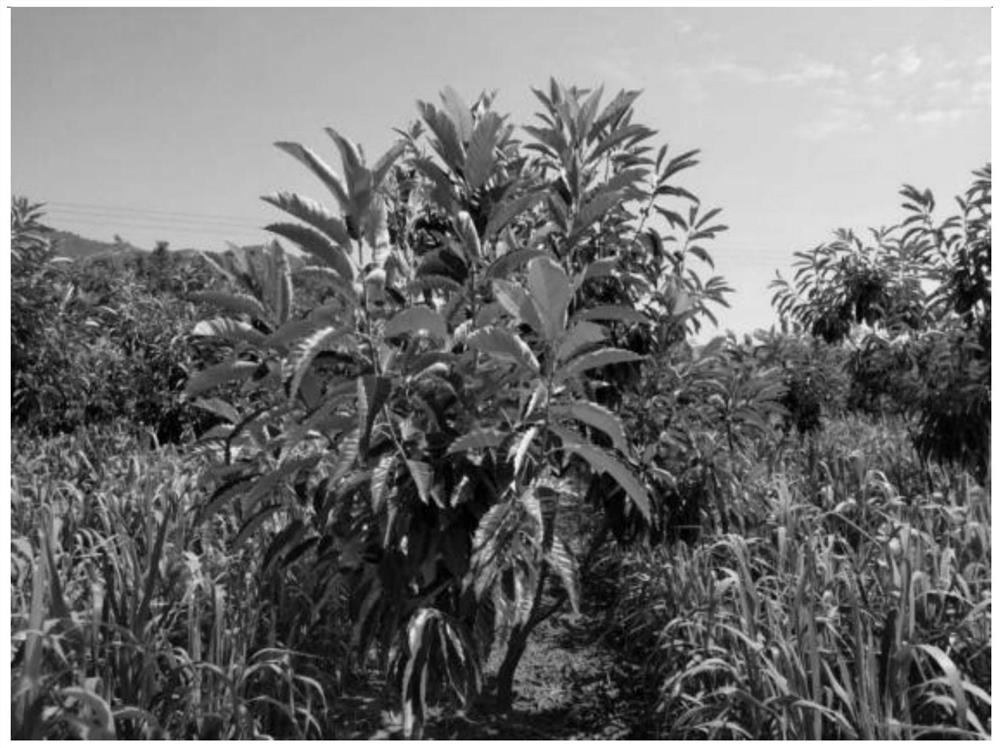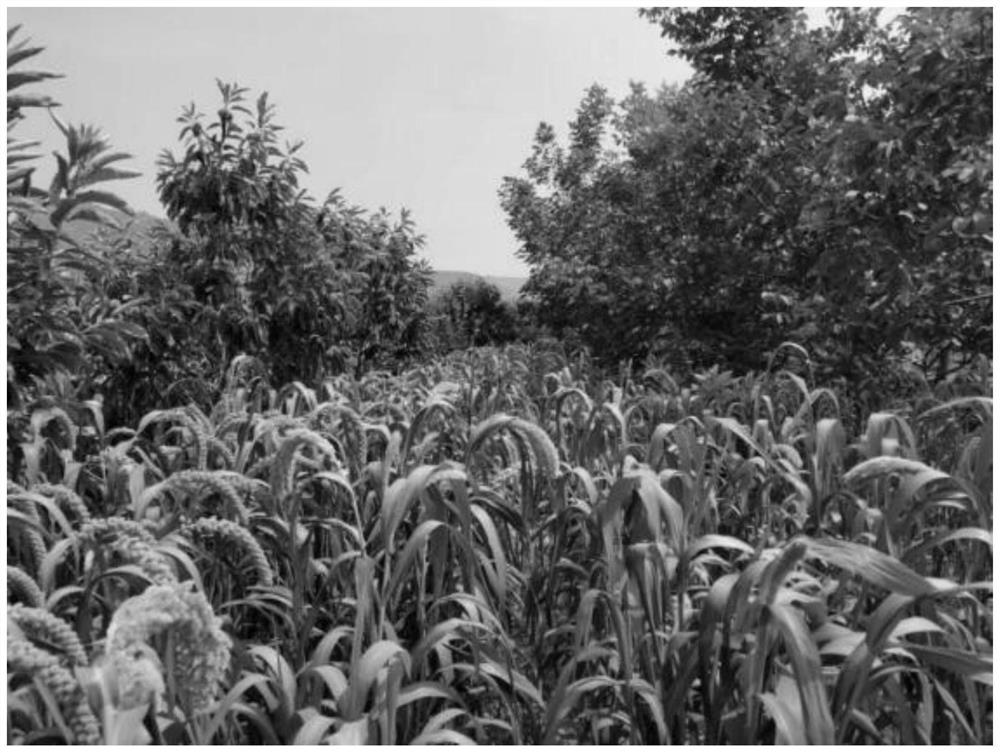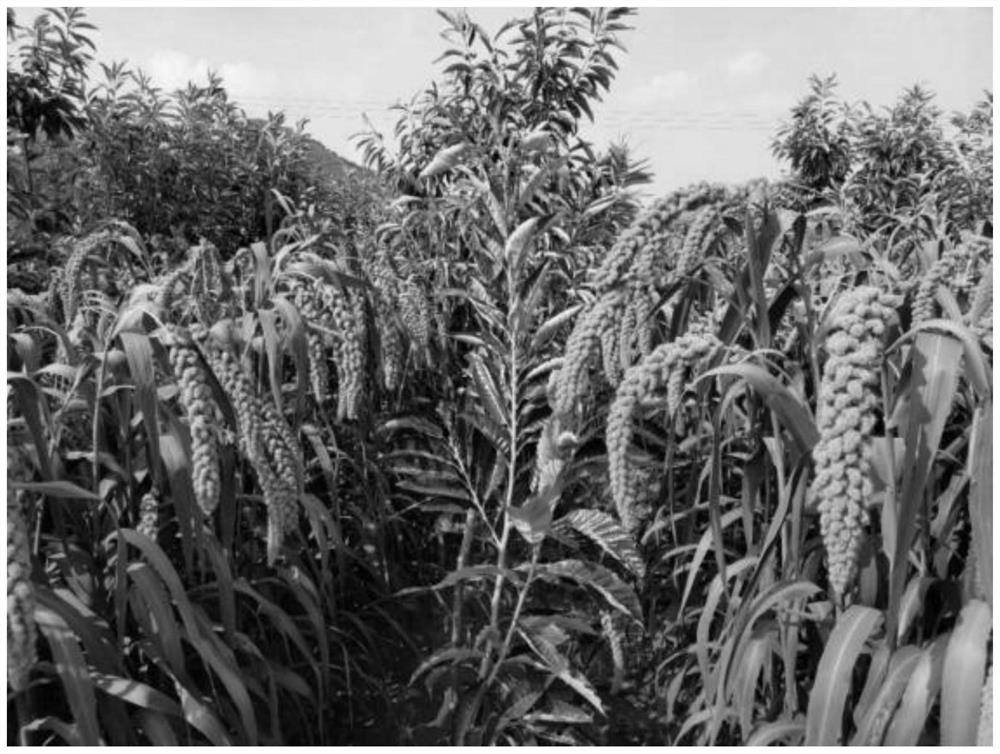Three-dimensional interplanting method of chestnut and shade-tolerant millet with synergistic coincidence of key growth stages
A developmental stage, millet technology, applied in biochemical equipment and methods, botany equipment and methods, microbial measurement/inspection, etc., can solve problems such as poor firmness, impact on walnuts, long growth period, etc., and achieve a good society and The effect of economic benefits
- Summary
- Abstract
- Description
- Claims
- Application Information
AI Technical Summary
Problems solved by technology
Method used
Image
Examples
Embodiment 1
[0068] Example 1, identification and screening of shade-tolerant millet germplasm resources.
[0069] From 2015 to 2016, the test materials were planted in Qianxi under both field and 10-year-old chestnut trees, and the plant height, firmness, photosynthetic efficiency and yield performance of 153 germplasm resources were determined, and comparative analysis was carried out, and the "Jigu 32, 56229, 3495, 51950, 56950, JK4-95, HK229, 56A, 51A" new varieties / germplasm resources with good shade-tolerant type were screened out, and these materials were planted under 10-year-old chestnut trees. Compared with the field, the photosynthetic rate is slightly reduced, the plant height, and the fruiting properties are almost unchanged. However, other materials show a large decrease in photosynthetic rate, due to the lack of sunlight exposure, the plant height has become significantly higher, and the firmness has decreased significantly.
[0070] Table 1 Identification results of shade-toler...
Embodiment 2
[0073] Example 2, the mining of shade-tolerant genes and the development of markers.
[0074] Taking the shade-tolerant germplasm resources Jigu 32, JK4-95 and non-shade-tolerant germplasm resources Jigu 31 and FK-1 screened by Example 1 as the materials, in mid-July 2016, the leaves of the sword trilobite were selected at the gestational panicle stage, and their transcriptome information was obtained by RNA-Seq; differential expression genes were obtained through differential expression analysis of the two types of material genes; their functions were further speculated by bioinformatics analysis and evolutionary analysis; some of the genes with more prominent functions were cloned; and then by gene sequencing. To explore its genetic sequence, a series of shade-tolerant markers were developed.
Embodiment 3
[0075]Example 3, the creation of shade-tolerant breeding materials (sterile lines, restoration lines).
[0076] Using the shade-tolerant resources screened in Example 1 as the material, a series of hybrid combinations were prepared; using the series of shade-tolerant molecular markers developed in Example 2, through the auxiliary selection of molecular markers, innovative shade-tolerant sterile lines, restoration lines.
[0077] 1) Creation of shade-tolerant sterile lines: in the summer of 2016, 56A and 51A were used as the mother, and KM200 and KM117 were used as the father to prepare the hybrid generation; in the winter of 2017, in Datong 29 and 206083, Hainan, the mother, the summer-formulated hybrid generation as the father, continued to formulate the triplet combination, and then after four consecutive generations of southern breeding and northern breeding, and according to molecular markers, selected shade-tolerant offspring to breed new sterile lines DZ40A and DZ386A.
[00...
PUM
 Login to View More
Login to View More Abstract
Description
Claims
Application Information
 Login to View More
Login to View More - R&D
- Intellectual Property
- Life Sciences
- Materials
- Tech Scout
- Unparalleled Data Quality
- Higher Quality Content
- 60% Fewer Hallucinations
Browse by: Latest US Patents, China's latest patents, Technical Efficacy Thesaurus, Application Domain, Technology Topic, Popular Technical Reports.
© 2025 PatSnap. All rights reserved.Legal|Privacy policy|Modern Slavery Act Transparency Statement|Sitemap|About US| Contact US: help@patsnap.com



